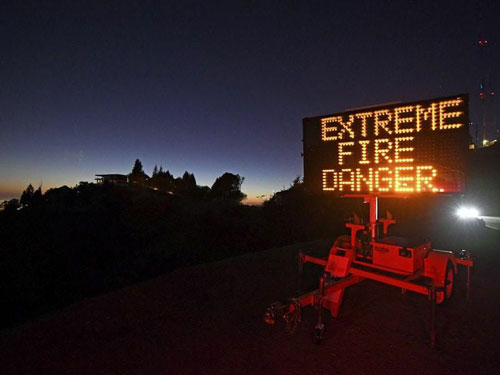Los Angeles
A fast-moving wildfire forced evacuation orders for 60,000 people in Southern California on Tuesday as powerful winds across the state prompted power to be cut to hundreds of thousands to prevent utility equipment from sparking new blazes.
The smoky fire exploded in size to over 3 square miles (7.8 square kilometers) within a few hours of breaking out shortly after dawn in Orange County, south of Los Angeles.
Strong gusts pushed flames along brushy ridges in Silverado Canyon toward houses in the city of Irvine, home to about 280,000 people. Kelsey Brewer and her three roommates decided to leave their townhouse before the evacuation order came in. The question was where to go in the pandemic.
They decided on the home of her girlfriend’s mother, who has ample space and lives alone.
“We literally talked about it this morning,” Brewer said, adding that she feels lucky to have a safe place to go. “We can only imagine how screwed everyone else feels. There’s nowhere you can go to feel safe.”
The cause of the fire wasn’t immediately known. More than 300,000 power customers — estimated at about 1 million people — were in the dark in the northern part of the state as officials issued warnings for what could be the strongest winds in California this year. Firefighting crews that had been at the ready overnight quickly contained small blazes that broke out Sunday in Northern California’s Sonoma and Shasta counties. The causes were under investigation.
North of San Francisco, a Mount St. Helena weather station recorded a hurricane-force gust of 89 mph (143 kph) late Sunday and sustained winds of 76 mph (122 kph). Some Sierra Nevada peaks registered gusts well over 100 mph (161 mph).
The “shut-offs probably did prevent dangerous fires last night.
It’s almost impossible to imagine that winds of this magnitude would not have sparked major conflagrations in years past,” Daniel Swain, a climate scientist with UCLA and the National Center for Atmospheric Research, said on Twitter.
Winds had calmed slightly by Monday, but still topped 60 mph (97 kph) and the strong winds and dry conditions were expected to prevail through Tuesday.
A second round of strong gusts is predicted to sweep through the same areas Monday night, the National Weather Service warned. Officials extended a red flag extreme fire danger warning through 5 p.m. Tuesday for the region’s eastern and northern mountainous areas.
Scientists have said climate change has made California much drier, meaning trees and other plants are more flammable.
October and November are traditionally the worst months for fires, but already this year 8,600 wildfires in the state have scorched a record 6,400 square miles (16,600 square kilometers) and destroyed about 9,200 homes, businesses and other buildings. There have been 31 deaths.
The electricity shutdowns marked the fifth time this year that Pacific Gas & Electric, the nation’s largest utility, has cut power to customers to reduce the risk of downed or fouled power lines or other equipment that could ignite blazes amid bone-dry weather conditions and gusty winds.
On Sunday, the utility shut off power to 225,000 customers in Northern California and later did so for another 136,000 customers in 36 counties.“This event is by far the largest we’ve experienced this year, the most extreme weather,” said Aaron Johnson, the utility’s vice president of wildfire safety and public engagement.
“We’re trying to find ways to make the events less difficult.”
The conditions could equal those during devastating fires in California’s wine country in 2017 and last year’s Kincade Fire that devastated Sonoma County north of San Francisco last October, the National Weather Service said.
Fire officials said PG&E transmission lines sparked that fire, which destroyed hundreds of homes and caused nearly 100,000 people to flee. Extreme fire danger moved into Southern California late Sunday following cooler temperatures and patchy drizzle over the weekend. A peak north of Los Angeles recorded a gust of 97 mph (156 kph).—AP










